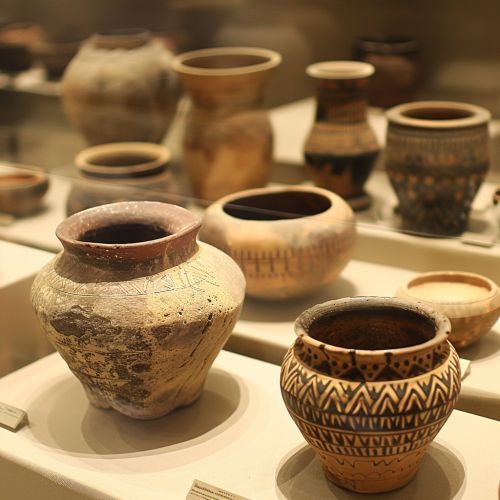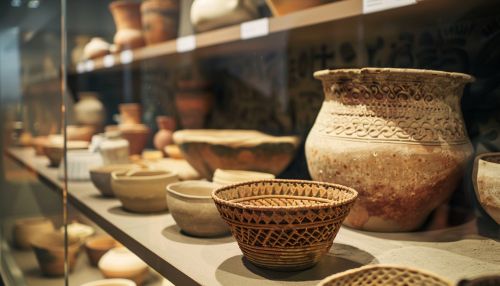History of Ceramics
History of Ceramics
The history of ceramics is a vast and intricate field that spans thousands of years, encompassing a wide range of cultures and technological advancements. Ceramics, derived from the Greek word "keramos" meaning "potter's clay," have been integral to human civilization since prehistoric times. This article delves into the comprehensive history of ceramics, exploring their evolution, cultural significance, and technological advancements.


Prehistoric Ceramics
The earliest known ceramics date back to the Upper Paleolithic period, around 28,000 BCE, with the discovery of the Venus of Dolní Věstonice, a figurine made from fired clay. This period marks the beginning of human experimentation with clay and fire, leading to the creation of rudimentary pottery and figurines. These early ceramics were primarily used for ritualistic and symbolic purposes rather than practical applications.
During the Neolithic period (approximately 10,000 BCE to 4,500 BCE), the advent of agriculture and settled communities led to significant advancements in ceramic technology. Pottery became essential for storing food and water, cooking, and other domestic uses. The development of the potter's wheel around 3,500 BCE in Mesopotamia revolutionized pottery production, allowing for more uniform and intricate designs.
Ancient Civilizations
Mesopotamia
Mesopotamia, often referred to as the cradle of civilization, played a crucial role in the development of ceramics. The Sumerians, Akkadians, Babylonians, and Assyrians all contributed to the evolution of ceramic techniques. Mesopotamian pottery is characterized by its utilitarian forms, such as jars, bowls, and beakers, often decorated with intricate geometric patterns and motifs.
The use of glazes in Mesopotamian ceramics began around 1,500 BCE, enhancing the aesthetic appeal and durability of pottery. These early glazes were typically composed of alkaline substances mixed with metallic oxides, producing a range of colors and finishes.
Egypt
In ancient Egypt, ceramics were integral to daily life and religious practices. Egyptian pottery, dating back to the Predynastic period (circa 4,000 BCE), includes a variety of forms such as amphorae, bowls, and figurines. The Egyptians developed distinctive techniques, including the use of faience, a glazed non-clay ceramic material made from ground quartz.
Faience was used to create a wide array of objects, from small amulets to large statues, often adorned with vibrant blue and green glazes. The Egyptians also pioneered the use of kilns, allowing for more controlled firing processes and consistent results.
China
China's contribution to the history of ceramics is unparalleled, with a rich tradition that dates back to the Neolithic period. Early Chinese pottery, such as the Yangshao culture's painted pottery (circa 5,000 BCE), showcases intricate designs and advanced firing techniques.
The development of porcelain during the Tang Dynasty (618-907 CE) marked a significant milestone in ceramic history. Porcelain, characterized by its translucency and high strength, was made from kaolin clay and fired at extremely high temperatures. This innovation led to the creation of exquisite ceramics that were highly prized both domestically and internationally.
Classical Antiquity
Greece
Greek ceramics, particularly those from the Classical period (circa 480-323 BCE), are renowned for their artistic and technical excellence. Greek pottery, including amphorae, kraters, and kylixes, often featured intricate scenes from mythology, daily life, and athletic competitions.
The Greeks developed several distinctive styles, such as the black-figure and red-figure techniques. In black-figure pottery, figures were painted in black slip on a red clay background, while red-figure pottery involved painting the background black and leaving the figures in the natural red color of the clay. These techniques allowed for greater detail and realism in the depiction of human figures and scenes.
Rome
Roman ceramics were heavily influenced by Greek traditions but also incorporated elements from Etruscan and other Mediterranean cultures. Roman pottery included a wide range of utilitarian and decorative items, such as amphorae, lamps, and terra sigillata, a type of fine red pottery with a glossy finish.
The Romans were adept at mass-producing ceramics, utilizing molds and standardized forms to meet the demands of their vast empire. Roman ceramics also featured intricate relief decorations and inscriptions, often depicting scenes of daily life, mythology, and imperial propaganda.
Medieval and Renaissance Ceramics
Islamic World
The Islamic Golden Age (circa 8th to 14th centuries) saw significant advancements in ceramic technology and artistry. Islamic potters developed new techniques, such as lusterware, which involved applying a metallic glaze to create a shimmering, iridescent effect. This technique was particularly popular in Persia, Egypt, and Spain.
Islamic ceramics were characterized by their intricate geometric and floral designs, often incorporating calligraphy and arabesques. The use of cobalt blue and turquoise glazes became a hallmark of Islamic pottery, influencing ceramic traditions across the Mediterranean and beyond.
Europe
Medieval European ceramics were primarily utilitarian, with limited artistic embellishments. However, the Renaissance period (circa 14th to 17th centuries) brought a renewed interest in classical art and craftsmanship, leading to significant developments in ceramic production.
Italian maiolica, a type of tin-glazed pottery, became highly prized for its vibrant colors and intricate designs. Renaissance potters in cities like Florence and Faenza produced exquisite maiolica wares, often depicting scenes from mythology, history, and daily life.
Modern and Contemporary Ceramics
Industrial Revolution
The Industrial Revolution (circa 18th to 19th centuries) transformed ceramic production, introducing mechanization and mass production techniques. The development of new materials, such as bone china, and advancements in kiln technology allowed for the production of high-quality ceramics on an unprecedented scale.
British potters, such as Josiah Wedgwood, played a pivotal role in the industrialization of ceramics. Wedgwood's innovations, including the development of creamware and jasperware, set new standards for quality and design in ceramic production.
20th and 21st Centuries
The 20th century saw a resurgence of interest in traditional ceramic techniques, alongside the development of new materials and methods. Studio pottery, characterized by small-scale, artisanal production, gained popularity as a reaction against industrial mass production.
Contemporary ceramics encompass a wide range of styles and techniques, from functional pottery to sculptural and conceptual works. Advances in materials science have led to the development of high-performance ceramics, used in a variety of industrial and technological applications, from aerospace to biomedical engineering.
